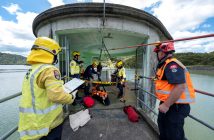There’s plenty of workplace health and safety trainers in the market but how do you make sure you’ve picked the right one for your firm?
Training is meant to change the way people do their jobs, or the way they behave or think. It is supposed to fill some identified skills gap, otherwise it is largely a waste.
So before you go looking for providers, it is important to think through what training you need. Be clear about what you need to achieve (see Preparation is key below).
What is the level of existing knowledge in the group to be trained? What do you need them to end up knowing?
Does everyone to be trained have an adequate grasp of English, or will you also need courses delivered in other languages? Will you want the training at your site or at the trainers’ centre(s)?
This kind of basic needs analysis will equip you to evaluate how far providers’ offerings match what you want.
If you already know you are looking for a standard accredited course contact the organisation and see if they have a list of approved training providers, which you can narrow down to those that serve your area.
For unaccredited courses, ask other safety managers in your locality for recommendations.
Cut to fit
Though you should know what you want, a good provider may push back if their experience suggests that there is a gap between what you say you want and what you really need.
They shouldn’t just be waiting to grab your money. They should want you to be satisfied and happy with your training and minded to use them again.
A prospective trainer should be able to take you through the options and advise you in a reasonably objective way.
Can they tailor courses to your requirements? If you want targeted training and are not fussy about having accreditation, then a bespoke course might give you best fit. Not all training providers can create a course from scratch or even modify an existing one.
Expect tailored courses to cost more. Training providers with a large repertoire of courses are in a better position to create bespoke content (including language variants) by modifying existing content in a cost-effective way.
Can they deliver it in the way you want? If you need the flexibility of splitting training sessions or delivering through e-learning, you need to establish this upfront.
Passing muster
Do they have a good reputation? As with any kind of contractor, it pays to get hard evidence of a potential training provider’s competence, rather than relying on hearsay. Ask for references from corporate clients, even from individuals they have trained.
Do they have experience in your business sector? This is less important for the more generic kinds of course, such as display screen equipment training, but crucial where you are contracting them for bespoke work.
For accredited courses, do they have good pass rates? (This shouldn’t be your only measure, as it is easy to fool with statistics and provide a non-representative sample result.) Where there will be face-to-face sessions, try to talk to one or more of the trainers who will be running your courses.
Is their approach — and are they — a good fit with your workforce? It is also important to see sample materials, or a demonstration course for e-learning, to see what you will be getting.
In all of the above analysis, be realistic. You are unlikely to find perfection, but a customer focused organisation will strive to adapt their offering to your requirements, resolve problems and keep you happy.
Though it’s easy to knock, ISO 9001 certification should give you some confidence that a training provider believes the customer is important.
Within budget
No one wants to pay over the odds but don’t expect good training on the cheap either. Value for money is what you are looking for and it helps to see value in terms of effectiveness. It makes sense to get several quotations but make sure you are comparing like with like.
Exploring the different ways of delivery will alter prices significantly — e-learning is generally cheaper than face-to-face tuition, but is less suitable for subjects where you need assurance that the training has stuck.
A good training provider should be able to work with you to identify what training is needed and how best to deliver it within budget so that it is effective.
It is probably better to offer a smaller amount of good, targeted training each year from a reputable provider than lots of generic ineffective training.
Preparation is key
All workers have a right to work in environments where risks to their health and safety are properly controlled.
But they must also remember that they are simultaneously responsible for their own health and safety and that of their colleagues.
It’s a multi-dimensional situation which makes the process of choosing the right training course especially thorny.
It is likely that a health and safety audit was performed fairly recently; this would have highlighted particular areas that need to be addressed.
So a sensible first step would be to revisit the reports and define what you need to achieve.
Another starting point could be a recent workplace risk assessment. This is a critical step in both ensuring the safety of your workers and protecting your business.
It’s a process whereby you methodically identify what could harm people in your workplace and what steps should be taken to either eliminate or manage the risk.
Part of managing any of the key risks identified by this process may involve training, e.g. if workers need to lift objects on some occasions such as boxes, do they know how to do that in a safe way?
If your organisation is small and you are confident you understand what’s involved, it is something you can undertake yourself:
- go through each room in your organisation and look at what could reasonably cause harm
- involve your employees and ask them if they have noticed anything.
If you are part of a larger organisation, consult your health and safety representatives and get their views.
The idea is to evaluate the risks and assess who in the workplace is exposed to them, in order to establish what kind of training is required, and for whom.
Before looking into specialist training relevant to a smaller proportion of your staff, it might be worth starting with a more generic course introducing the principles of health and safety so all employees understand their role and responsibilities within your organisation.
Choosing the right format
Training providers tend to offer a wide range of course delivery options, usually public courses in dedicated training centres, bespoke training delivered in-house and e-learning or distance learning.
Each solution offers clear advantages so it is important to understand what will best meet your needs.
Start by establishing the number of employees to train, the training budget available, and the general availabilities of the delegates.
Public courses are ideal when you have few employees to train who can afford to take time out of the office.
For many people, studying in a dedicated training environment away from the office is beneficial for concentration, whilst interacting with others from a different sector as it can help getting a wider understanding of the issues covered.
If you have a larger group of employees to train, but would still like them to benefit from face-to-face training and interaction with other learners, consider in-house training. It also means that no travel or accommodation costs are incurred.
E-learning or distance learning can be a relatively inexpensive way to train staff. Another benefit is that it can give the learner flexibility in terms of when they can do the course, so that it can fit around other work and personal commitments.
It is worth involving employees at this stage of the selection process. For instance, you may consider conducting a survey and finding out which specific methods of training have proven helpful in the past, or indeed which specific methods would work best for them.




